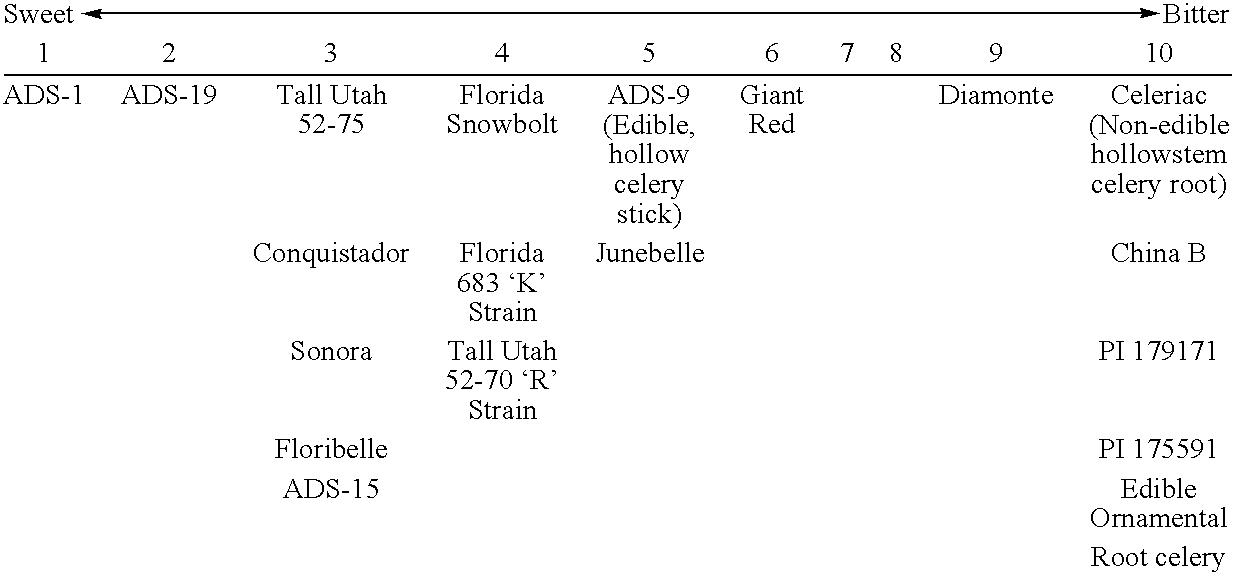Hollow Celery Stick
a celery stick and stick technology, applied in the field of celery products, can solve the problems of difficult to perform reliable hybridization, small celery seed, unmarketable stalks, etc., and achieve the effect of effective reduction of stalk size and yield
- Summary
- Abstract
- Description
- Claims
- Application Information
AI Technical Summary
Benefits of technology
Problems solved by technology
Method used
Image
Examples
example 1
Flavor of the Hollow Celery Stick
[0128]The development of a new class of edible hollow celery stick was initiated in order to provide an edible product that would be functional as celery straws and food stuffed hollow celery products. Until a suitable edible hollow celery stick variety was developed, no final product development could occur for straws or stuffed products.
[0129]The present invention is developed from, or utilize edible hollow celery stick as a primary ingredient may differ in their specifications of the hollow celery stick that is required in the product / process.
[0130]The present invention differs from celeriac and root celery products that are currently available in that the hollow petioles of the celery of the present invention have a thickened and succulent leaf petiole that has a mild taste, whereas the hollow-stick or petiole of celeriac and root celery (Apium graveolens L. var. rapaceum) such as the celeriac variety PI 179171 have enlarged hypocotyls and upper ...
example 2
Texture of the Hollow Celery Stick
[0142]The fibrous character in celery is a reflection of the types and nature of the cells that the tissues of the celery are composed of. A cross section of the celery petiole of a conventional stem celery variety is characterized by a thin layer of epidermal and chollenchyma cells at the surface and a layer of palisade mesophyll cells just below the surface. These cells are characterized by smaller cells having less vacuoles storing water and the region has a greater level of fibrous cell wall material. It is also reinforced with a higher percentage of thin parenchyma cells containing cellulose microfibrils which provide reinforcement and affect the fibrous nature. This region of the celery also has fairly rigid vascular bundles running vertically through the stem. The tissue below these cells and constituting the center of the petiole is composed of spongy mesophyll cells which contain large vacuoles filled with water, air and other metabolic sub...
example 3
Preparation of the Hollow Celery Stick
[0182]In the preparation of a product for the marketplace, raw hollow celery sticks of the present invention are harvested by hand or machine in the field similar to standard stem celery and placed in bins, totes or cartons and cooled. Cooling will usually be performed by utilizing hydro-vac cooling, hydro cooling or forced aircooling methods typical of most raw vegetables, but other methods may be used.
[0183]The initial processing steps may include cleaning steps often used for raw vegetables to assure cleanliness and food safety.
[0184]Once the hollow celery of the present invention is cooled, the cool process will be maintained within the range of 33° F. to 40° F. unless the specific product or process requires a break in that chain.
[0185]In the present invention, a whole celery stalk is trimmed to remove the butt and foliage. The celery may either be cut by hand or mechanical means such as a saw or knife. It may also be cut with a water knife...
PUM
 Login to View More
Login to View More Abstract
Description
Claims
Application Information
 Login to View More
Login to View More - R&D
- Intellectual Property
- Life Sciences
- Materials
- Tech Scout
- Unparalleled Data Quality
- Higher Quality Content
- 60% Fewer Hallucinations
Browse by: Latest US Patents, China's latest patents, Technical Efficacy Thesaurus, Application Domain, Technology Topic, Popular Technical Reports.
© 2025 PatSnap. All rights reserved.Legal|Privacy policy|Modern Slavery Act Transparency Statement|Sitemap|About US| Contact US: help@patsnap.com


